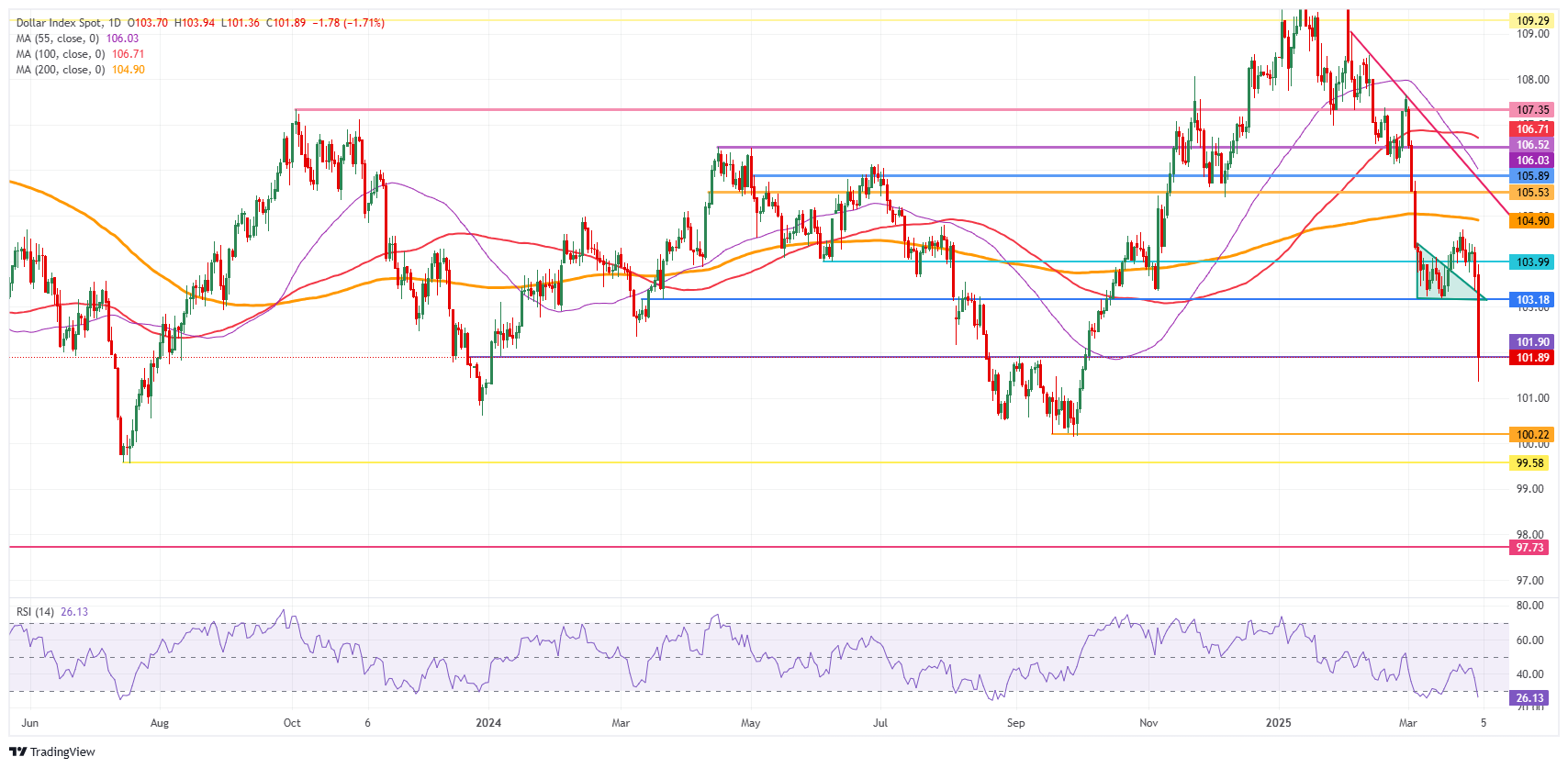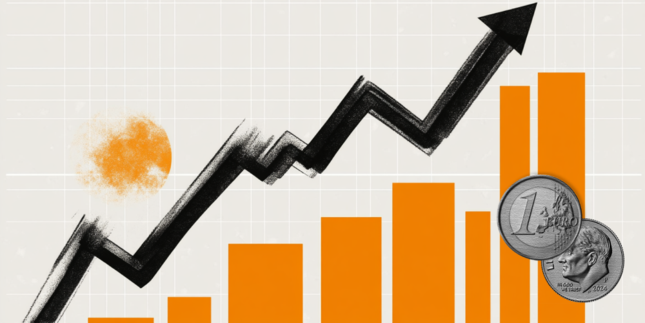US Dollar unable to recover as losses already amount to an excessive 2.10% in the DXY
- The Greenback is one of the victims in financial markets of Trump's reciprocal tariffs.
- A base 10% tariff for all countries exporting goods to the US and additional levies per country with China facing a sum of 54%.
- The US Dollar Index is hit hard and falls below the 102.00 level and even drops below 101.50.
The US Dollar Index (DXY), which tracks the performance of the US Dollar (USD) against six major currencies, is getting knocked out and is against the canvas. The Greenback got slashed after United States (US) President Donald Trump had set off the tariffs atomic bomb by issuing elevated reciprocal tariffs on Wednesday. The US Dollar is being kicked out of portfolios while investors repatriate cash as they sell their stakes in US Equities amidst a harsh correction globally.
Markets are digesting the reciprocal tariffs that were implemented overnight by the United States (US) President Donald Trump, where a global 10% tariff is the minimum base case for the 60 countries that are exporting to the US. From there, all other earlier tariffs remain in place, which means, for example, a total of 54% tariff on China applicable as of this Thursday. Meanwhile, the daily economic calendar continues with the US weekly Jobless Claims, ISM Services print and the Challenger Job Cuts for March to be released.
Daily digest market movers: ISM confirms US economy rout
- Treasury Secretary Scott Bessent commented, after the announcement of reciprocal tariffs by Trump, that tariffs could quickly be lifted or removed if countries bring back their production to the US. Bessent issued a statement as well, saying that it’s best for countries not to retaliate as this could be considered the worst-case scenario if they want to avoid more tariffs.
- The US Challenger Job Cuts for March are seeing further cuts, coming in at 275,240 with the previous release at 172,017.
- The US weekly Jobless Claims data is due. Initial Claims came in stronger at 219,000, beating the 225,000 estimate and coming from 224,000. The Continuing Claims jumped to 1.903 million, higher than the 1.856 million previously.
- The US S&P Global final Services Purchasing Managers’ Index (PMI) reading for March came in at 54.4, just above the initial reading of 54.3.
- The US Institute for Supply Management (ISM) has released the March Services report:
- Services PMI fell to 50.8, a big miss on the estimate of 53.0 and coming from 53.5.
- The Employment component fell into contraction, hitting 46.2 after coming from 53.9.
- New Orders came in just above 50, at 50.4 after its previous reading of 52.2.
- Prices Paid fell to 60.9, from earlier 62.6.
- Equities are facing sharp corrections on the back of the overnight headlines. European equities are down between 2.00% to 3.00% on average. US equities are even seeing the Nasdaq plunge over 4% on the day.
- According to the CME Fedwatch Tool, the probability of interest rates remaining at the current range of 4.25%-4.50% in May’s meeting is 74.7%. For June’s meeting, the odds for borrowing costs being lower stand at 72.5%.
- The US 10-year yields trade around 4.04%, just off its fresh five-month low at 4.01% as a massive flight to safe haven Bonds is taking place.
US Dollar Index Technical Analysis: Markets got what they deserved
The US Dollar Index (DXY) is finally coming alive after consolidating around the 103.00-104.00 range for nearly a month. With this shock effect in markets, the DXY falls below the 102.00 cushion and tests the support of the 101.90 technical level on Thursday. Once that level breaks, another chunky area will open up for further devaluation of the Greenback, with the 100.00 round level as a downside target.
With the sizable downward move on Thursday, some support levels have turned into resistance. The first level to watch out for comes in at 103.18, which has held as support throughout March. Above there, the 104.00 pivotal level and the 200-day Simple Moving Average (SMA) at 104.90 come into play.
On the downside, 101.90 is the first line of defense, and it should be able to trigger a bounce as the Relative Strength Index (RSI) momentum indicator is issuing warnings of oversold conditions in the daily chart. Maybe not this Thursday, but in the coming days, a break below 101.90 could see a leg lower towards 100.00.

US Dollar Index: Daily Chart
Banking crisis FAQs
The Banking Crisis of March 2023 occurred when three US-based banks with heavy exposure to the tech-sector and crypto suffered a spike in withdrawals that revealed severe weaknesses in their balance sheets, resulting in their insolvency. The most high profile of the banks was California-based Silicon Valley Bank (SVB) which experienced a surge in withdrawal requests due to a combination of customers fearing fallout from the FTX debacle, and substantially higher returns being offered elsewhere.
In order to fulfill the redemptions, Silicon Valley Bank had to sell its holdings of predominantly US Treasury bonds. Due to the rise in interest rates caused by the Federal Reserve’s rapid tightening measures, however, Treasury bonds had substantially fallen in value. The news that SVB had taken a $1.8B loss from the sale of its bonds triggered a panic and precipitated a full scale run on the bank that ended with the Federal Deposit Insurance Corporation (FDIC) having to take it over.The crisis spread to San-Francisco-based First Republic which ended up being rescued by a coordinated effort from a group of large US banks. On March 19, Credit Suisse in Switzerland fell foul after several years of poor performance and had to be taken over by UBS.
The Banking Crisis was negative for the US Dollar (USD) because it changed expectations about the future course of interest rates. Prior to the crisis investors had expected the Federal Reserve (Fed) to continue raising interest rates to combat persistently high inflation, however, once it became clear how much stress this was placing on the banking sector by devaluing bank holdings of US Treasury bonds, the expectation was the Fed would pause or even reverse its policy trajectory. Since higher interest rates are positive for the US Dollar, it fell as it discounted the possibility of a policy pivot.
The Banking Crisis was a bullish event for Gold. Firstly it benefited from demand due to its status as a safe-haven asset. Secondly, it led to investors expecting the Federal Reserve (Fed) to pause its aggressive rate-hiking policy, out of fear of the impact on the financial stability of the banking system – lower interest rate expectations reduced the opportunity cost of holding Gold. Thirdly, Gold, which is priced in US Dollars (XAU/USD), rose in value because the US Dollar weakened.
BRANDED CONTENT
Choosing a broker that aligns with your trading needs can significantly impact performance. Our list of the best regulated brokers highlights the best options for seamless and cost-effective trading.
Forex News
Keep up with the financial markets, know what's happening and what is affecting the markets with our latest market updates. Analyze market movers, trends and build your trading strategies accordingly.





















